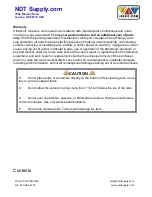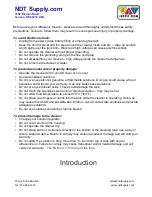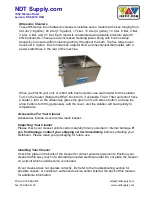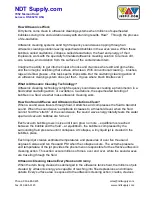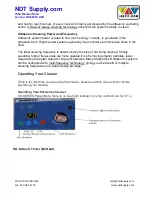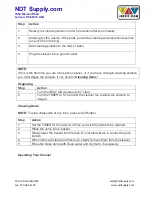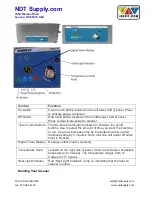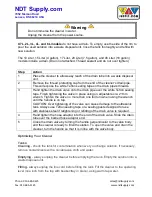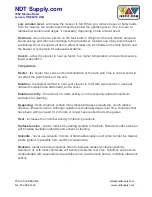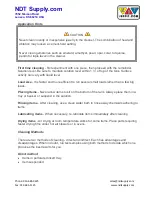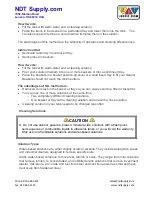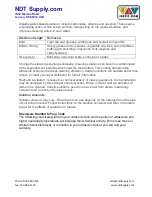
NDT Supply.com
7952 Nieman Road
Lenexa, KS 66214 USA
Phone: 913-685-0675
Fax: 913-685-1125
www.ndtsupply.com
How Ultrasonics Work
Dirty items come clean in ultrasonic cleaning systems when millions of superheated
bubbles scrub grime and oxidation away with stunning results. How? Through the process
of de-cavitation.
Ultrasonic cleaning systems send high frequency sound waves ripping through an
ultrasonic cleaning solution leaving superheated bubbles in the waves’ wake. When these
bubbles, called cavitations, collapse, called decavitation, the heat and energy of their
implosions work with the specially formulated ultrasonic cleaning solution to remove dirt,
oils, residue, and oxidation from the surface of the contaminated item.
Imagine the ability to get into the tiniest of nooks and crannies where dirt and grime hide,
and then imagine scrubbing that surface ultra clean. With conventional cleaning
– brushes,
rags and elbow grease
– this task seems impossible. But the cavitating cleaning action of
an ultrasonic cleaning system does just that
– It goes where brush bristles can’t.
What is Ultrasonic Cleaning Technology?
Ultrasonic cleaning technology is high frequency sound waves creating a phenomenon in a
fluid called cavitating action, or cavitations. Cavitations, the superheated bursting of
bubbles in a fluid, are what make ultrasonic cleaning work.
How Can Sound Waves and Ultrasonic Cavitations Clean?
When a sound wave travels through fluid, it stretches and compresses the fluid to transmit
sound. When the sound wave's amplitude increases to a threshold level, when the fluid
cannot hold the “stretch” of the sound wave, the sound wave energy literally tears the water
apart and vacuum bubbles are formed.
Each vacuum bubble grows in size until it can grow no more
– equilibrium is reached
between the bubble and the fluid
– at equilibrium, the bubble is compressed by the
surrounding fluid pressure until it collapses. At collapse, a tiny liquid jet is created in the
bubble’s place.
Each liquid jet creates estimated temperatures and pressures of over five thousand
degrees Celsius and ten thousand PSI when the collapse occurs. The extreme pressure
and temperature of the jet provides the phenomenon responsible for the effective ultrasonic
cleaning action. This action occurs millions of times, over and over, while the sound waves
are traveling through the fluid.
Ultrasonic Cleaning Cleans Every Nook and Cranny
When the item being cleaned is submerged in the ultrasonic tank’s fluid, the millions of jets
created by ultrasonic energy are capable of reaching into fine depressions and intricate
details. Every surface area is exposed to the ultrasonic cleaning action; cracks, crevices


